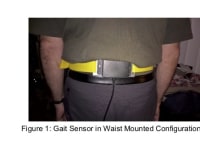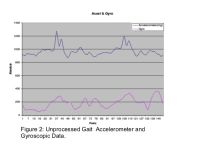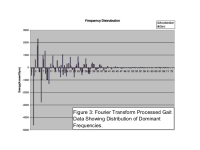We have invented a non-invasive sensor capable of identifying the unique gait signatures of cannabis and alcohol impaired subjects as well as those of Parkinson's disease, multiple sclerosis, traumatic brain injuries, Alzheimer's syndrome and related conditions. Moreover, by employing proprietary sensor data processing algorithms, the measured gait data can be evaluated in real time to provide warnings to clinical patients of impending falls.
Although gait assessment instruments have been demonstrated in the past, our invention can analyze gait measurements in real time so as to recognize signature gait patterns of specific clinical conditions. It can therefore be used as a screening tool for early detection of a wide variety of neurological conditions before their symptoms become overtly manifest. We envision use in evaluation and monitoring of the elderly, athletes, military members and returning astronauts. Additionally, the technology can be employed to screen for and provide objective evaluation of suspected substance-impaired drivers. These capabilities are provided by a non-invasive, lightweight and compact externally worn instrument.
Conceptual feasibility has been demonstrated using the developmental brassboard sensor shown in Figure 1. This device has been worn in pilot tests to measure gait characteristics and to develop signal processing algorithms for the sensor data stream.
The breakthrough capability of our sensor to provide stability alerts in real time is the result of applying proprietary guidance and control sensor data processing methodologies developed by Equinox for aerospace applications. The invention uses sensitive, high speed accelerometers and gyroscopic sensors oriented in pitch, yaw and roll axes, providing 6 degrees of freedom real-time information at 150 Hz. These devices provide 150 measurement points per second during a gait assessment. We will be able to tune the sensor rates as necessary to support higher rates as needed. Whereas similarly dense data sets recorded by the trials mentioned above have proved daunting for real time evaluation, our invention instead applies Fourier Transform analysis to the sensor data stream, greatly reducing the signal processing burden and the future need for high speed communication in a production device.
Figures 2 and 3 display the unprocessed signal flow recorded during a gait assessment trial run and the Fourier Transform spectrum obtained from the raw pitch, yaw and roll axis accelerometer and gyroscopic data using our proprietary frequency domain signal processing algorithms. The raw data displayed in Figure 2 were collected during the completion of one complete stride cycle. Although interesting in a qualitative sense, such unprocessed plots provide neither predictive information of falls nor diagnostic identification of specific neurological pathologies or impairment.
In contrast, the Fourier transform processed stride data shown in Figure 3 reveal the dominant frequencies associated with an individual's gait. This ensemble of frequencies and their associated amplitudes comprise a unique signature. For clinical applications, empirically determined signature variations characteristic of strokes, imbalances, etc. can be monitored in real time to provide warnings and summon assistance from caregivers.
Like this entry?
-
About the Entrant
- Name:Russell Mellon
- Type of entry:teamTeam members:Equinox Interscience, Inc.
Vista Life Sciences, Inc. - Software used for this entry:Solid Works, Spice, MathLab
- Patent status:none








